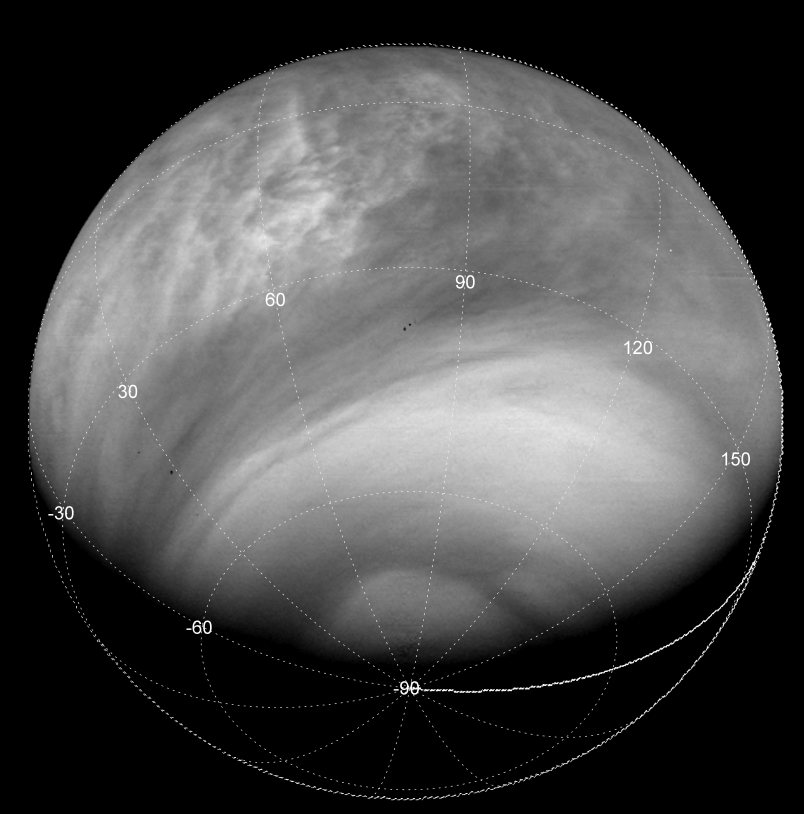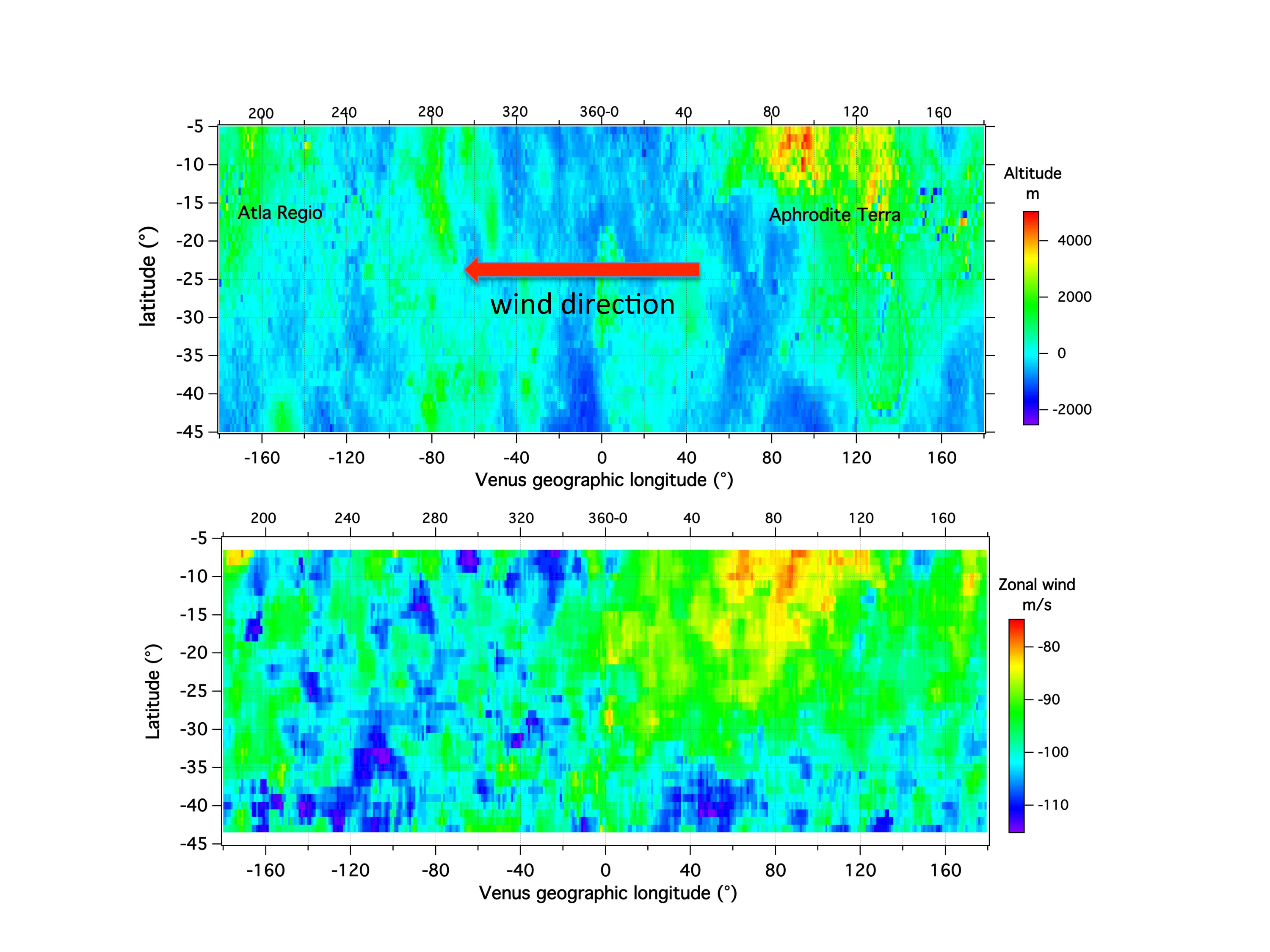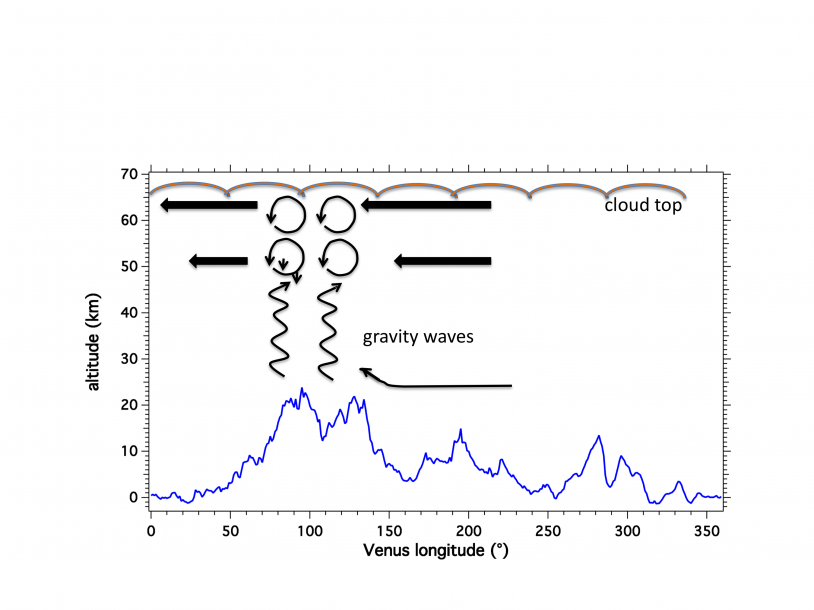The planet Venus is often described as Earth’s evil twin sister. The ground temperature is 460°C, a consequence of the greenhouse effect produced by the very thick atmosphere of carbon dioxide (CO2). The pressure is huge – 95 times stronger than on Earth.
The planet is enshrouded in a thick mantle of clouds extending up to 70 km above the surface, preventing the observation of its surface except in UV light. Some UV details are darker than others; their motion allowed in 1961 to discover that clouds were moving at high speed (some 100 m/s or 360 km/h) from east to west.
It was initially thought that the whole planet was rotating at this speed, making one full rotation in four days. But Venus’s solid body actually spins very slowly, in 243 days, and in the same direction as the clouds. Therefore, the wind regime at high altitude has been called a “super-rotation”.
What’s more, radar mapping (in particular from NASA’s Magellan orbiter) has produced detailed topographic maps of the surface of Venus, revealing impact craters and mountains likely to be of volcanic origin.
In this context, a team of European scientists (France-Germany-Russia) which analyzed several years of UV images collected by the Venus Monitoring Camera (VMC), on board ESA’s Venus Express mission (2006-2014) has recently published a surprising discovery, linking what occurs at cloud top level to the presence of mountains underneath, though the summits are far below the clouds.

An example of VMC image (through a UV filter at 365 nm) taken from a distance of around 33,000 km on the day side. The comparison of two successive images allows to determine the motion of particular UV clouds and markings and to derive wind velocity at cloud top level. These winds are moving from east to west (from right to left in the picture). A latitude-longitude grid is indicated.
CLOUD COLOR AND WIND SPEED GIVE INFORMATION ON THE RELIEF.
The team established that the clouds were brighter in UV above the mountains above the great Aphrodite Terra mountains, and that wind velocity was significantly slowed down to 82 m/s, whereas it is about 100 m/s at other longitudes.
It is as if terrestrial clouds were brighter above Himalaya and moving at a slower pace. But while on Earth, even the highest clouds are not far above the highest summits, there is a difference of about 65 km of altitude on Venus. However, scientists were able to propose an explanation for this new Venus feature only based on an analogy with a terrestrial mechanism.

Above, the topographic map of Venus obtained from NASA’s Magellan radar mission. Altitude is color coded. There is in the observed region a large mountainous region, Aphrodite Terra, and a smaller one, Atla Regio, south of equator. The zonal wind is oriented from right to left, from east to west, toward decreasing longitudes (red arrow). Maps are centered on the 0° longitude. The scale 0 to 360° longitude is indicated on the top axis. The names of the highlands are written south of the reliefs. Below it, the map of the zonal wind speed recorded by VMC on Venus Express in m/s (color coded). There is a region of strong minimum (in absolute value) which is located ~30° downstream of the Aphrodite Terra highlands of Figure 2a; this region extends further south in latitude. The wind map was obtained from a set of 31,604 manual measurements.
On Venus, the wind is weak at ground level, but the air density is very high, i.e. 93 times higher than on Earth. The flow of air above a mountain can therefore generate orographic waves – so-called gravity waves that are similar to sea waves, but made of air. On Venus, they propagate upward while growing in amplitude until they cannot propagate anymore, and they break suddenly, like sea-waves on the beach, just below the cloud top. These waves are fixed geographically with respect to the mountains, while the high altitude wind (65-70 km) is usually about 100 m/s. it has been observed that wave breaking is an obstacle to wind flow and decreases the wind speed downstream of the mountain.
Sketch of gravity waves generated at ground level by the interaction of the zonal wind blowing on the mountains, propagating upward, breaking in the altitude region 50-60 km and decelerating the zonal wind at this altitude and higher. The blue curve is the average altitude within the latitude band from -5° south -15° south. The altitude of the relief is exaggerated by a factor 7 for better clarity. The black arrows represent the direction and magnitude of the winds.
As the horizontal circulation continues, wind velocity catches up to its normal value of 100 m/s. This acceleration causes the air mass to stretch at cloud top level: a sort of vacuum is formed and sucks up the air underneath. VMC UV images are darker downstream of the mountain, which demonstrates that this upwelling of air is carrying from below the (still unidentified) material absorbing UV solar radiation. The Venus UV absorber was already believed to come from below, but we now have a dazzling proof of it – if we may say so of a dark material.
Simultaneously, another completely independent Venus Express observation has confirmed the proposed scheme. The near Infra-red spectrometer of the SPICAV instrument was able to map water vapor at cloud top level, and found a geographic region of enhanced water vapor – the same region where clouds are darker. This can easily be explained by the well-known fact that there is more water vapor when going further into the clouds. Therefore, re-accelerating winds cause the air underneath (richer in both dark UV material and water vapor) to be sucked up.
Models of general atmospheric circulation for Venus are built like the ones used for weather forecasts on Earth.
One of the most sophisticated is the French model of Sébastien Lebonnois from Laboratoire de Météorologie Dynamique. Though this model takes into account the actual topography and is able to reproduce the observed super-rotation of Venus, it is not yet able to reproduce the current Venus Express observations of wind speed reduction. Finding the missing ingredient to complete the model which would reproduce the observations therefore constitutes a stimulating challenge. This new observed mechanism of orographic origin has an impact on horizontal flow and opposes super-rotation. This must be taken into account for a better description of super-rotation generation and persistence.
This interaction of stationary gravity waves with horizontal wind was proposed for the first time for Earth by the atmospheric physicist Lindzen in 1981. It was invoked to explain the seasonal behavior of winds in Earth’s mesosphere (50-70 km of altitude).
On this subject, it is worth recalling that the two small balloons launched in 1985 in the Venus atmosphere as part of the Soviet missions Vega-1 and Vega-2, as proposed by Jacques Blamont, did not behave identically during their two-day travel at 53 km of altitude: the Vega-2 balloon, drifting over the Aphrodite Terra mountains, had a slower drift and a more perturbed trajectory than the Vega-1 balloon, flying north of Aphrodite Terra over a region of flat plains. The generation of gravity waves by the wind blowing over Aphrodite Terra had then been invoked to explain the different behavior of the two balloons.
REfErences OF THE publication
Bertaux, J.-L.1, Khatunstsev, I.V.2, Hauchecorne, A.3, Markiewicz W.J.4, Marcq E.1, Lebonnois, S.5, Patsaeva, M.2, Turin, A.2, Fedorova, A.2, (2016), Influence of Venus topography on the zonal wind and UV albedo at cloud top level: the role of stationary gravity waves, Journal of Geophysical Research Abstracts, 18, EGU2016-16126.
1 IMPEC - LATMOS (Laboratoire Atmosphères, Milieux, Observations Spatiales)
2 IKI - Space Research Institute
3 SHTI - LATMOS
4 Max Planck Institute for Solar System Research
5 LMD (Laboratoire de Météorologie Dynamique)
Contacts
Scientific Contacts:
- Jean-Loup Bertaux, LATMOS (jean-loup.bertaux at latmos.ipsl.fr)
- Alain Hauchecorne, LATMOS (alain.hauchecorne at latmos.ipsl.fr)
- Sébastien Lebonnois, LMD (sebastien.lebonnois at lmd.jussieu.fr)
Head of the Solar System Program:
Francis Rocard, CNES (francis.rocard at cnes.fr)
